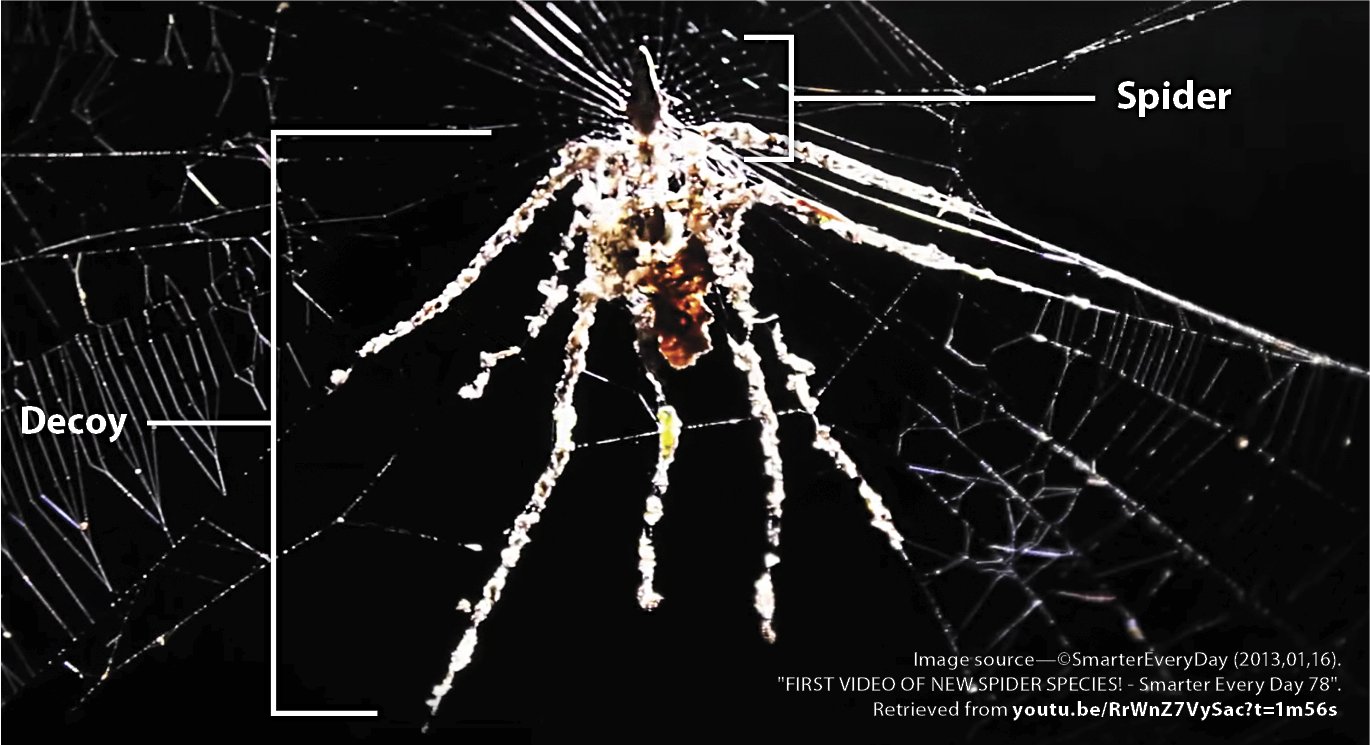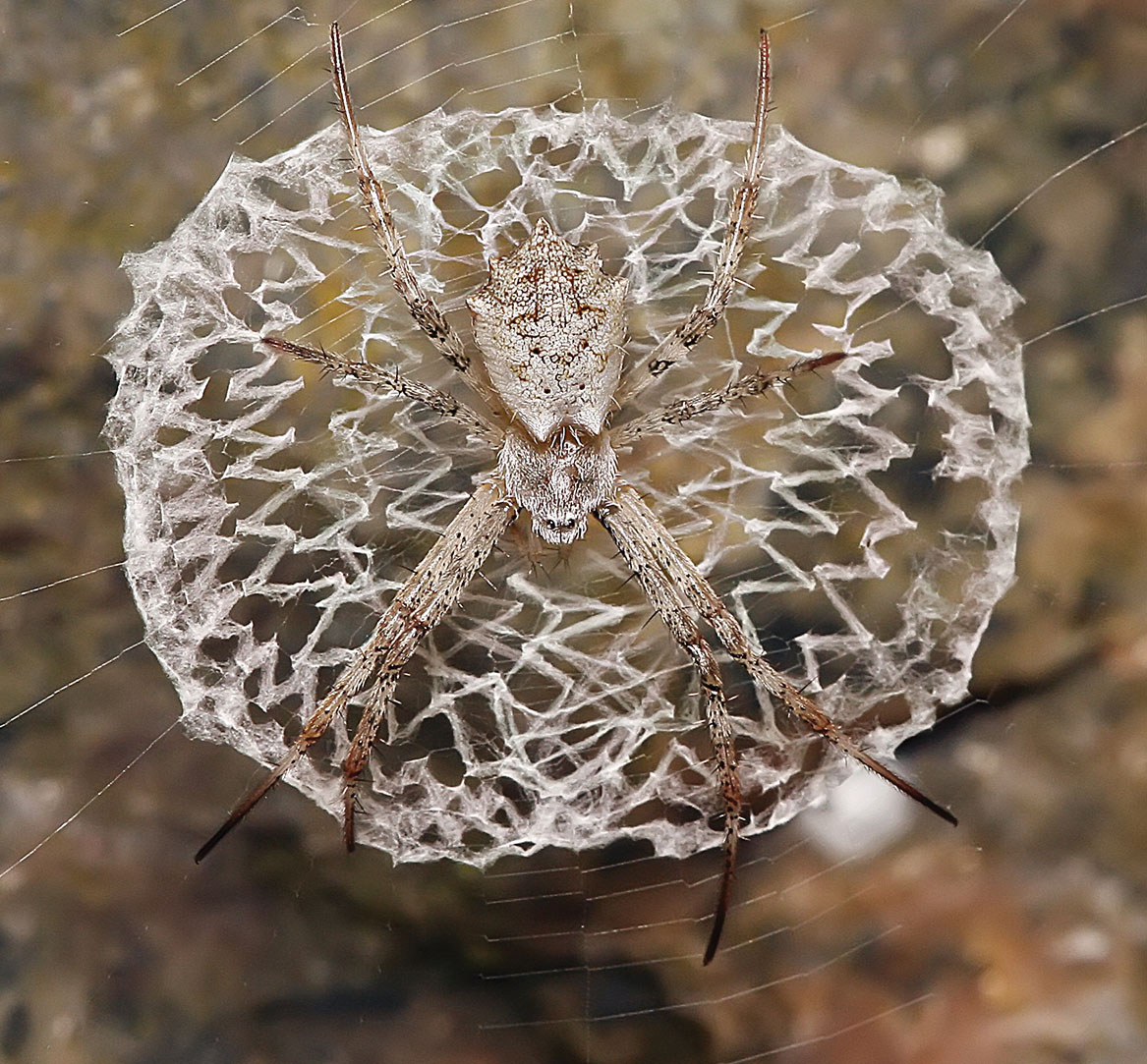Spider decoy
These spiders aren’t dummies (or are they?)

Camouflage is a design feature used by many creatures to protect themselves in this sin-cursed world. Typically, camouflage is used to imitate an environment in order to blend in and hide.
A related form of ‘deception for safety’ is called mimicry, in which a creature impersonates another species. For instance, to lower its chance of being eaten, it might imitate (in appearance, behaviour or both) a very unpalatable or poisonous species that a predator knows to avoid. Some creatures even mimic specific predators that frighten other predators away.
Recently, two independent studies have revealed a creature that mimics itself! And one could say it does so in a ‘big’ way.
In 2012 two US biologists independently discovered an amazing behaviour, each in a different species of spider of the Cyclosa genus.
The two spider species live 18,000 km (11,000 miles) apart—one in the Amazon basin in Peru, the other in the Philippines.
Unbeknown to each other at the time, both scientists discovered spiders using forest debris (bark, leaves, moss and even the corpses of insects) to create replicas of themselves in the middle of their webs. The copies are often incredibly detailed (see photo fig. 1, and caption), complete with eight legs and the general layout of a spider body. The only major difference in appearance—the dummies were about ten times larger than their creators! The result was a rather realistic image of a ‘giant spider’ that either (1) presented a menacing appearance to creatures that might have dared to pick on a smaller spider or (2) provided a false target for undeterred predators that mistook the decoy for the real owner of the web.
To add to the realism of the imitation spiders, it was found that the real spiders also caused these realistic decoys to move when predators were near. By shaking their webs, their doppelgänger2 creations appeared to come to life!
Not only is this behaviour fascinatingly complex, but it also seems unprecedented in the animal kingdom. No other creature is known to create a larger decoy of itself to escape predation.
Evolution explains it?
An internet image search will display hundreds of pictures of the creatures and their zombie-like creations. Not surprisingly, a hand-waving mention of evolution is thrown in now and then trying to ‘explain’ how these incredibly sophisticated activities in such a ‘primitive’ creature arose naturalistically.

Evolutionist, biologist and educator Phil Torres wrote of the find that it “seems like a really well evolved and very specialized behavior” which seems to at least acknowledge its complexity. But then, as if to play it down, he goes on:
Considering that spiders can already make really impressive geometric designs with their webs, it’s no surprise that they can take that leap to make an impressive design with debris and other things … .3
But is it really that easy? Pointing out that spiders can make ‘impressive geometric designs’ without explaining how they can (but assuming ‘evolution did it’) and then saying it’s therefore not surprising they can do something even more complex is hardly a good explanation for the origin of the ability!
Admittedly, for invertebrates, spiders are a lot smarter than many think; they are able to solve complex mazes, and their brains, though minuscule, can be extensive for their body size.4 The brains of some smaller spiders even extend into their legs. But of course, they have extremely limited behaviour compared to humans. No scientist, evolutionist or otherwise, would seriously suggest that this spider has the reasoning power to be able to think through the idea of creating an effigy of itself to help keep it alive.
Rather, all would agree that the construction of these Spider decoys, along with the ‘puppeteering’ of them, is programmed into the creatures genetically (i.e. they are following ‘blind instinct’). So could that arise by evolution?
Evolution is supposed to occur as mutations (genetic accidents) create new genetic information which is then ‘chosen’ by natural selection if the accident gives a significant survival advantage to the organism. Never mind that the overwhelming majority of mutations observed are information-losing (not surprising, since it’s far easier to break something than make it).
Assuming this behaviour developed incrementally from spiders that didn’t build decoys, what kinds of changes would this require?

The genus Cyclosa is within the family Araneidae, the members of which are also known as ‘orb weavers’ for their characteristic circular webs. The group’s many detailed similarities strongly suggest membership of the same created kind (baramin).1
The baramin may in fact be at the level of the family, Araneidae. Perhaps even the superfamily (Araneoidea) which includes two families whose members were previously all regarded as in the family—the Tetragnathidae (Long-Jawed Orb Weavers), and the Nephilidae (Golden Orb Weavers).
It seems likely, though, that the Hackled Orb Weavers or Uloboridae belong to a separate baramin (kind), as their sticky web silk is of a quite different makeup. The striking similarities of their web construction to other orb weavers would reflect commonality of design, something which evolutionists often ‘explain away’ using the handy phrase ‘convergent evolution’ (evolution hitting upon the same solution in different groups coincidentally).
Perhaps an initial mutation affecting behaviour caused the spiders to randomly gather and arrange a simple clump of debris in their web. An evolutionist might argue that this somehow gave them a slight selective advantage (although clumps of debris fall into spider webs all the time, with seemingly no advantage to spiders of any sort). Perhaps this was by frightening away some predators a little more than a web without a clump. Then allegedly a similar accident caused the behaviour to be such that the arrangement was ever so slightly more spiderlike (e.g. head/thorax).
This then means that predators are even more likely to avoid it, which then gives a further slight selective advantage—and so on step by step, through fortuitous mutations that cause the spiders to instinctively arrange debris like legs. Each slight incremental advantage is then supposed to head it ever closer to the full-blown ‘spider’ appearance.
Because of the difficulty people would have believing this sort of tale if it happened in big, lucky jumps, evolutionists like Richard Dawkins routinely argue that such advantages only have to be very slight to keep evolving towards seeming wonders of design, like the eye. When challenged as to what use half an eye would be to selection, the classic argument he uses in rebuttal is that blurred vision is obviously better than none, less blurred vision better still, and so on. But the Achilles’ heel of all such selectionist arguments is the evidence from population genetics that tiny advantages cannot be selected for. A figure of 10% fitness advantage—i.e. a substantial advantage—has been cited as the minimum that selection can ‘see’.5
Creationists are aware of natural selection and have highlighted its important role in adaptation after creation—even to the extent of speciation (e.g. the dog kind on the Ark giving rise to dingoes, coyotes, wolves etc.). But this requires significant built-in programming to begin with, and can only account for fairly minor ‘fine tuning’ post-creation.6
The degree of complexity involved in the decoy spider’s repertoire strongly suggests, rather, that the information was present in the genome of the original spider kind. Interestingly, other Cyclosa spiders that are almost certainly descended from the same Genesis kind exhibit different, simpler types of web-sculpting behaviour—see the box concerning Cyclosa conica. This spider builds a simpler web structure from debris, called a stabulimentum (fig. 2), and even rattles it to scare away predators.

This may be a part-degenerated remnant of the more complex ‘decoy’ behaviour that others have retained. But that does not necessarily mean that all spiders in that kind were rattling decoys immediately after creation. In a three-part series in Journal of Creation, molecular biologist Peer Terborg defended the idea that the genomes of the kinds were ‘front-loaded’ at creation to allow rapid adaptation/speciation.7 The decoy spider’s repertoire, though programmed at creation, may not have been expressed in all or any of the original population. In fact, it may only have been activated after the Fall.8
Our earlier ‘step by step’ scenario was an example of a typical evolutionary story to explain why we observe creatures like decoy spiders in the present, but is also a fine illustration of how the creation/evolution debate is in the realm of historical, not operational, science. No one ever observed the types of changes described, and this is really just an example of storytelling. If you believe it happened like that, you believe it ultimately by (blind) faith, not by observation. As famous evolutionist Ernst Mayr once said;
Evolutionary biology, in contrast with physics and chemistry, is a historical science—the evolutionist attempts to explain events and processes that have already taken place. Laws and experiments are inappropriate techniques for the explication of such events and processes. Instead one constructs a historical narrative, consisting of a tentative reconstruction of the particular scenario that led to the events one is trying to explain.9
Even if we ignore the complex biochemistry and anatomy of the organs required to produce the silk, web building is itself a highly complex behaviour, difficult enough to explain in evolutionary terms. However, constructing a highly detailed replica of yourself, hiding beside it and manipulating it so it looks as if it is alive when danger is near, is significantly more sophisticated. To believe that kind of programmed instinct could come about by the selection of random mutations takes great faith. Reason indicates instead that the decoy spider’s programmed behaviour reflects the intelligent programming of the omniscient, all-powerful Creator God.
References and notes
- The only (scant) hybridization data seemingly available involves a different group, the funnel web weavers. Return to text.
- Lookalike or body double (loanword from German, literally ‘double walker/goer’). Return to text.
- Drake, N., Spider that builds its own spider decoys discovered, wired.com/2012/12/ spider-building-spider/, 18 December 2012. Return to text.
- Gourdarzi, S., The amazing spider brain: a great mystery in a tiny head, braindecoder.com, accessed 28 August 2016. Return to text.
- This is highlighted by prominent geneticist Dr John Sanford in his classic work Genetic Entropy. Return to text.
- See Grigg, R., The love trap, Creation 24(3):26–27, 2002; creation.com/orchid. Return to text.
- The articles start at creation.com/genetic-redundancy. Return to text.
- See creation.com/bad-things-in-creation. Return to text.
- See creation.com/mayr. Return to text.




Readers’ comments
Comments are automatically closed 14 days after publication.